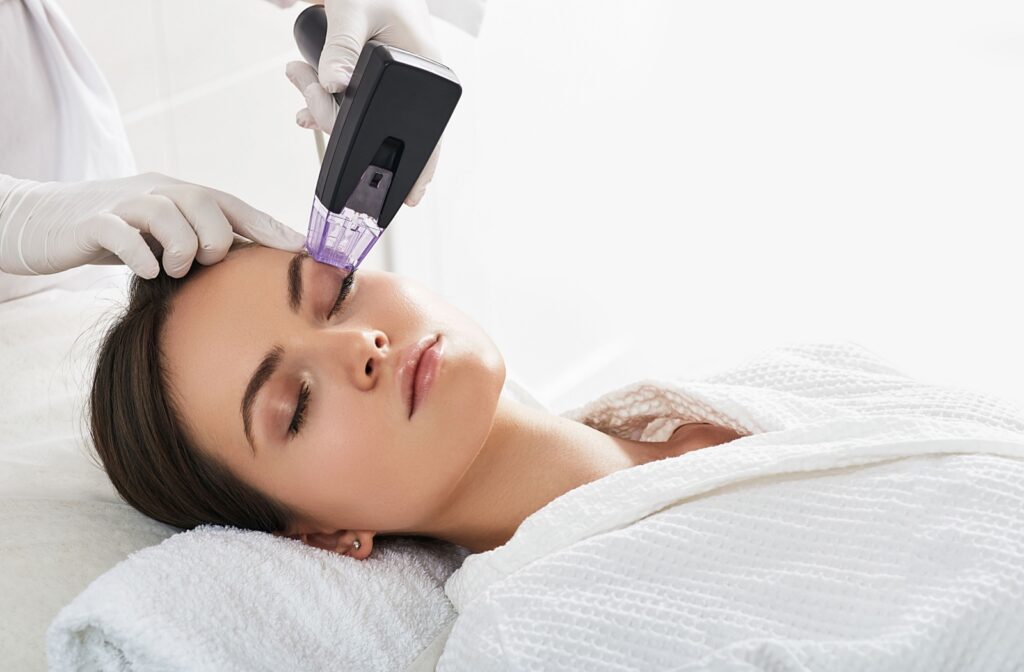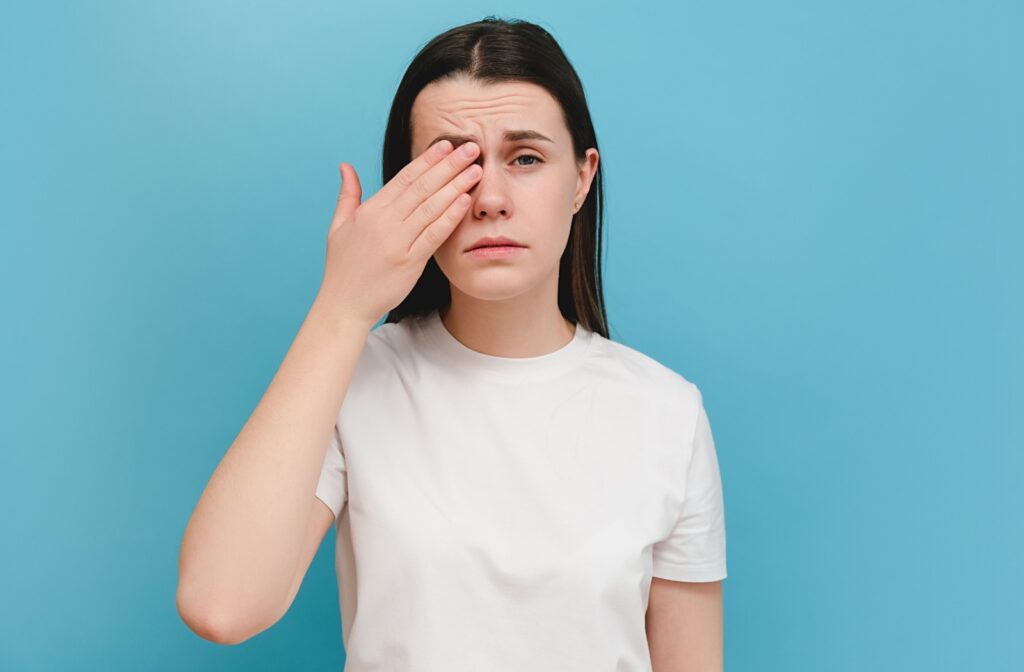If you’ve been experiencing persistent discomfort or dryness in your eyes, Meibomian Gland Dysfunction (MGD) may be the culprit. If you’re no stranger to Idaho’s hot, dry summers, dry eye syndrome–a condition commonly linked to MGD–might sound familiar.
Meibomian Gland Dysfunction can be temporary or chronic, depending on its underlying cause, though it’s common to experience flare-ups or periods of no symptoms. The severity of MGD varies case by case, but advanced dry eye therapies can help address these concerns by targeting the root cause.
Long-term relief from dry eye symptoms is closer than you think. A dry eye consultation can determine which treatment is right for you!
All About Meibomian Gland Dysfunction
Meibomian Gland Dysfunction (MGD) is a condition that affects the tiny oil-producing glands along the edges of your eyelids, known as meibomian glands, which support a healthy tear film. When these glands aren’t working as they should, it leads to irritating symptoms like inflammation, dryness, and persistent discomfort.
Beyond helping you express intense emotions, tears play a functional role in your eye health. They protect the eyes from irritants and debris while keeping the surface moist. Balance is the key to a healthy tear film. Therefore, a disruption in any of its layers (the oil component concerning MGD) leads to instability and results in uncomfortable symptoms.
Meibomian glands can malfunction because of blockages or clogs, which cause insufficient oil secretion or the production of low-quality oil. This results in Evaporative Dry Eye, one of dry eye’s most common forms.
Several factors can contribute to MGD, including:
- Aging: A decline in gland function with age is common.
- Hormonal changes: Fluctuations, especially during menopause, may affect the glands.
- Chronic eyelid inflammation (blepharitis): Inflammation and irritation from chronic conditions like blepharitis or rosacea can hinder normal gland function.
- Prolonged screen use: Long hours on digital screens can cause you to blink less frequently, affecting the natural flow of oil from your glands.
- Environmental factors: Living in a dry or windy climate, ongoing air conditioning or heating system use or poor eyelid hygiene can aggravate existing dryness.
Although MGD isn’t a life-threatening condition, it can significantly affect your comfort, visual clarity, and overall quality of life without proper management.
How Long Does MGD Last?
Without a thorough evaluation, there’s no certainty of how long MGD can last.
MGD may be a temporary concern for some people, and with appropriate management, last only a few weeks. However, with chronic cases or without proper treatment, MGD can persist for months or even become a long-term condition.
The longevity of MGD symptoms depends on several factors:
- Initial severity: Mild cases of MGD may respond quickly to lifestyle changes or over-the-counter treatments, while severe cases may require ongoing care.
- Commitment to treatment: Sticking to prescribed therapies like eyelid hygiene routines or professional interventions significantly influences results.
- Underlying causes: Chronic conditions such as rosacea or blepharitis can aggravate MGD and lengthen or complicate recovery.
It’s worth recognizing that MGD is sometimes part of an ongoing cycle of inflammation and gland obstruction. This cycle can perpetuate without proper intervention, making it challenging to achieve long-lasting relief.
At Vision One Boise, our approach to MGD treatment focuses on addressing the symptoms and the root cause of dysfunction, which usually requires ongoing management rather than a one-time solution.

Advanced Dry Eye Therapies
Our expert team is passionate about all areas of vision care, especially dry eye therapies.
We stimulate meibomian glands to encourage healthy functioning (addressing the root cause of MGD) while improving the tear film’s overall quality with advanced therapy techniques.
Here’s greater insight into the treatments we offer:
OptiLight by Lumenis
OptiLight uses Intense Pulsed Light (IPL) technology to reduce inflammation around the eyes, targeting one of MGD’s root causes, and improving tear quality. With care and control, the light from the device helps unclog any obstruction in the meibomian glands to restore normal function.
With consistent treatment, OptiLight stimulates natural gland activity, enhancing tear production and overall eye health, while relieving discomfort from dryness.
TempSure Envi
This treatment uses radiofrequency (RF) energy to gently heat the skin surrounding the eyes, targeting any obstruction in the meibomian glands to improve their overall function.
As a bonus, TempSure Envi simultaneously stimulates collagen production in the skin, enhancing its overall appearance!
Through consistent sessions, TempSure Envi helps stimulate and restore meibomian glands and improve tear film health, offering long-term relief from MGD symptoms.
Additional Therapies
Although these advanced therapies are a powerful tool, we also incorporate other dry eye solutions to complement and support gland health:
While OptiLight is a powerful tool, we also incorporate alternative dry eye solutions to complement and support gland health:
- Warm compress mask: Carefully heat this mask in the microwave and apply it over your closed eyelids. Gently massage the skin around the area to help remove any clogs in the meibomian glands and restore their function.
- Lid hygiene: Practice good eyelid hygiene and always remove eye makeup. Special lid wipes can help remove debris like bacteria, dirt, or flaky skin around the eyelids, which can contribute to MGD.
- Vitamins and nutraceuticals: A healthy diet fuels your body. We can suggest the right supplements to help support healthy tear production.
These tools can help maintain the results of your advanced treatments, offering a comprehensive approach to managing MGD, reducing symptoms, and restoring overall visual clarity and comfort.
Experience Long-term Relief
The key to maintaining good eye health is visiting your optometrist for timely management when something feels off. Addressing MGD early helps improve visual clarity, comfort, and overall quality of life while avoiding long-term concerns.
Our comprehensive approach to MGD through advanced therapies and at-home remedies can help you find long-term relief from persistent discomfort. A dry eye consultation is a step in the right direction. Connect with Vision One Boise today and schedule an appointment!



